1929 - End of the Golden Era: Into the Depression
From the opening programme, State Theatre, Sydney

Photos by John Thiele
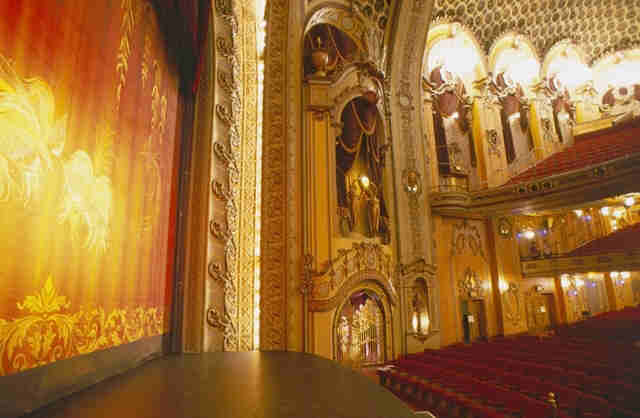
By now, excitement was growing in Sydney, as there
arose in Market Street, on a prime piece of central city
real estate, the loveliest and most opulent theatre ever
built in the Southern Hemisphere. While the State
Theatre, Sydney, was not Australia's largest cinema (it
seated 2775, as against 3371 at the State Theatre,
Melbourne) [both these theatres were claimed at their respective
openings to seat 4000!], it was certainly the most lavish.
The State Theatre, Sydney, was the epitome in Australia of the "hard top" school of cinema architecture, and was (and still is) sumptuous to a degree parallelled and exceeded only in America. When it was originally planned, in February, 1927, construction cost were budgeted at £400,000, [Sydney Morning Herald, 16 February, 1927] at a time when the basic wage was £4/10/0 a week, a peak it did not regain for another thirteen years [Alan Sharpe, Nostalgia Australia, Sydney, 1975, p.93]. However, it seems that the final cost of the whole building, far exceeded that amount:
"The bill for the erection of the State Theatre (which also incorporated an office and shopping complex) came to a million pounds. In comparison, the £500,000 which Union Theatres spent on the Melbourne State seems almost modest. The major Regent theatres each cost approximately £300,000 - quite an advance on the £14,000 outlay required to construct Hoyt's first theatre." [Diane Collins, Hollywood Down Under, North Ryde, NSW, 1987 p. 116]
Its (mostly) Louis XIV-style interior represents a quality
and dignity far
surpassing the
"atmospheric" interiors of the Capitol Theatre, Sydney,
Ambassador's Theatre, Perth, and State Theatre, Melbourne.
Its art-deco functional exterior contrasts not unfavourably
with the State Theatre, Melbourne's ostentatious oriental
fantasy.
Price Dunlavy at the console of the State, Sydney's Wurlitzer, 1929
The State Theatre, Sydney, was equipped with an equally luxurious Wurlitz er organ, a twin to
those at the Regent and State Theatres in Melbourne. Like them, it
had twenty-one ranks of pipes. It was shipped with a second
console and a grand piano; however, there was no room to install
the second console, and space was so restricted that the piano
was soon removed. Its "French" style console, painted white and
gold from opening day, reflects exquisitely the graceful curves of
the gilded gateways recessed into the proscenium walls. In few
theatres in the world was such a happy match achieved. Opening
night, 7 June, 1929, found Price Dunlavy at the console as it
spiralled gracefully out of its pit.
er organ, a twin to
those at the Regent and State Theatres in Melbourne. Like them, it
had twenty-one ranks of pipes. It was shipped with a second
console and a grand piano; however, there was no room to install
the second console, and space was so restricted that the piano
was soon removed. Its "French" style console, painted white and
gold from opening day, reflects exquisitely the graceful curves of
the gilded gateways recessed into the proscenium walls. In few
theatres in the world was such a happy match achieved. Opening
night, 7 June, 1929, found Price Dunlavy at the console as it
spiralled gracefully out of its pit.
Organ, dance band and two pianos at the State
A short video clip of a stage and orchestra (with organ) production at the State, Sydney, with Hamilton Webber at the console can be downloaded by clicking here. You will need Windows Media Player or some other suitable viewer to play it
Hoyt's completed their series of major "Regents" in the mainland State capitals on 8 November, 1929, when the Regent Theatre, Brisbane, opened.
In many ways, its architecture and colour scheme were the most attractive and elegant of all the Regents. It housed a three-manual, fifteen-rank Wurlitzer organ, which was opened by Stanley Wallace. The instrument was unusual in two respects. First, it had the only three-manual "French" style console on an Australian Wurlitzer. Second, it was the only organ console in Australia prior to the 1960s to be installed on an electric lift; all other lifts at that time were hydraulically operated. It was also the last new Wurlitzer pipe organ to be sent to Australia.
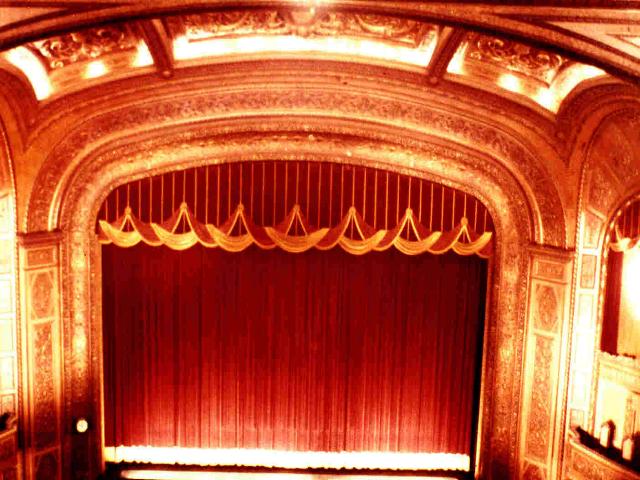
Regent, Brisbane
By now, the storm clouds were gathering for the cinema exhibition industry. Just over a week earlier, on 29 October, 1929, the New York stock market crashed, bringing instant ruin to millions, as stock values plummeted along with brokers who jumped from nearby buildings. Perhaps the worst catastrophe to strike the developed world had occurred. The Roaring twenties ended, and in came the Turbulent Thirties, and with then the Great Depression. Along with the rest of the Western World, Australia suffered as badly as, if not worse than, other countries.
Before all this broke, the cinema industry in Sydney noted a minor sensation in late September, 1929, when Hal Carleton (General Manager), Eddie Horton (Organist) and T W O'Shea (Projectionist), all employed at the Prince Edward Theatre, Sydney, resigned from that theatre on three months' notice to take control of a new theatre to be opened in Parramatta "early in December" [ Everyone's, 25 September, 1929, p.7].
The Roxy Theatre, Parramatta, was
not to open until 6 February, 1930,
part of the delay being caused by
the late arrival of the Christie organ
from England [Letter from John Hurst &
Co., Chartered Accountants, Sydney, to
Eustace Ingram, Hill Norman & Beard, Ltd.,
London, 11 December, 1929]. This was a
three-manual, ten-rank, instrument,
which many consider to have been
Christie's best Australian
installation. The excellent
Spanish-style architectural
treatment, complete with a pleasant
courtyard forming the approach to
the theatre (similar to that at
Grauman's Egyptian Theatre in
Hollywood), which is well set back
from the road, caused it to be
regarded as "probably one of the most, if not the most opulent or richly-designed suburban picture
palace in Australia". [Ross Thorne, Cinemas of Australia via the USA, Sydney, 1981, p. 323]

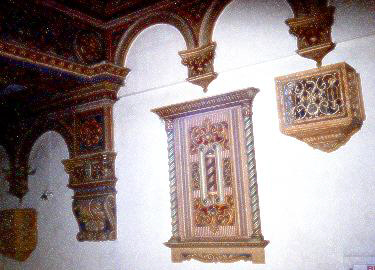
Roxy, Parramatta, 2001

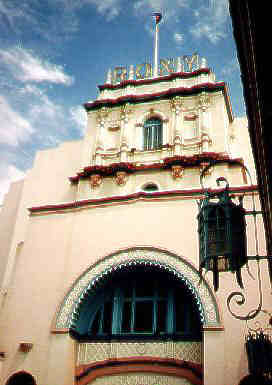
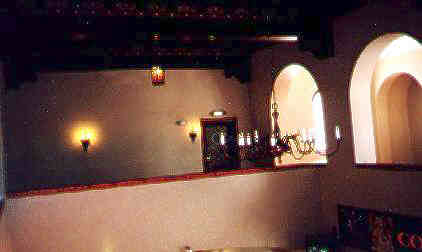
A couple of months later, another Spanish-style theatre opened in Sydney. This was the Plaza Theatre, Sydney. The Plaza opened on 11 April, 1930, and in it was installed a Christie organ, not a new one, but the organ from the De Luxe Theatre, Melbourne, which it is believed was originally installed in the Regent Theatre, North Perth. Eddie Fitch was at the console. The theatre was perhaps the last (apart from the rebuild of the Regent Theatre, Melbourne) of the lavish 1920s-style picture palaces to be built in Australia, and its elaborate interior made a fitting end to an era we are unlikely to see repeated.

Plaza, Sydney (1999)
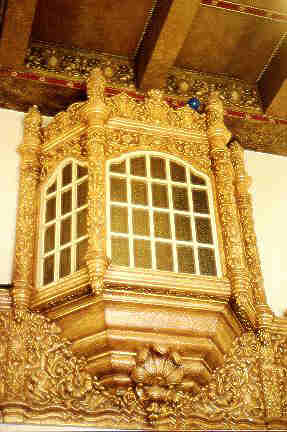
Why were such lavish and costly picture palaces built? Was it merely the result of the exhibitors' wish to please patrons, as the publicity material would have us believe?
Some revelation came in Stuart Doyle's evidence to the NSW Government film industry inquiry in 1934, that Union Theatres' construction programme was "created at the request and virtually under threats from certain American film distributors, for the purpose of finding an outlet for their pictures, which, in their opinion, would earn greater revenue ... in larger modern theatres." [Diane Collins, Hollywood Down Under, North Ryde, NSW, 1987 p. 116]
There were also other more political reasons:
"The erection of handsome picture palaces - the pride of any town - served as a concrete rebuff to the idea that reformist groups propagated of an insidious, grasping and morally decadent picture industry... While parliamentarians debated the need for a government inquiry into the industry, a representative of Hoyt's thought it at least politic to state that their recent efforts in the cinema building field were partly 'directed towards making the Commonwealth Government realise that they were trying to do something in Australia for the benefit of all Australians'." [Diane Collins, Hollywood Down Under, North Ryde, NSW, 1987 pp. 117-8]
When all was said and done:
"In the 1920s, new and powerful rivals to the cinema emerged in the form of automobiles and radios, and other diversions became more accessible with the spread of affluence. Thus the picture palace, with its inimitable blend of novelty, luxury and exclusiveness, served as powerful propaganda for the special character of film entertainment. Not only were the picture palaces potent means of getting people out of their homes and away from the wireless, but also their exotic environments rivalled any landscape through which the motorist might drive. In short, the luxury cinemas gave movie-going a sense of occasion - one thing that a rival like radio obviously lacked - and the buildings lent a new sense of visual excitement to the familiar images on the screen." [Diane Collins, Hollywood Down Under, North Ryde, NSW, 1987 p. 120]
Christie's advertisement on 7 May, 1930, included a partial list of their installations world-wide. This list included theatres in England, Scotland, Wales, Czechoslovakia, Austria, Germany, New Zealand and Australia. They ranged from their magnum opus of 37 ranks at the Regal Theatre, Marble Arch, London, to the exotic Metropol Theatre, Bratislava, redolent of middle-European intrigue, and the more plebeian Lido Theatre, Islington (London). The Australian installations listed are:
Lyceum, Sydney
Victory, Kogarah
De Luxe, Melbourne
Plaza, Sydney
Ritz, West Concord (NSW)
[Everyone's, 7 May, 1930, p. 43]
An omission is the King's Theatre, Gordon, NSW, where an eight-rank Christie had been opened on 14 October, 1929. A further omission is the Roxy Theatre, Parramatta (NSW). Interestingly, both the De Luxe Theatre, Melbourne, and the Plaza Theatre, Sydney, are listed, although the same instrument had been removed from the former and relocated in the latter.
The Lyceum Theatre, Sydney, organ had 9 ranks, and was unusual in including two Diapason ranks. The large Diapason and the Clarinet were unenclosed, the remaining seven ranks being housed in a single chamber. The theatre was (and still is) used by the Methodist Church for services on Sundays. During the week they lease it for use as a cinema. The instrument is still in situ and used for Sunday services. It miraculously survived a fire in the 1960s which destroyed most of the auditorium, after which it was completely rebuilt with a new ("straight") stop-key console and considerably reduced unification. It has been said that this organ has never been used for film shows, and has been played only for church purposes (and concerts), but the writer has been unable to confirm or deny this.
The Ritz Theatre, West Concord, housed a small 5-rank organ which was soon removed and installed in enlarged (8-rank) form in the Melba Theatre, Strathfield, NSW.
The economic impact of world events soon began to be felt in Australia, and for a time few new theatres appeared.
In 1931, a Christie organ of seven ranks was built and set up as a demonstration instrument in Hill, Norman & Beard's factory in Clifton Hill, Melbourne. Most, if not all, of this instrument was constructed in Melbourne, and it differed in many ways from Christie's earlier Australian installations. The instrument was even broadcast from the factory, and in 1932 it was installed in the Duke of York's Theatre, Eastwood, NSW.
Despite Christie's 1928 statement that parts of their organs were then being constructed in Melbourne, very little, if anything, actually was at that time. This can be seen clearly from the shipping manifest for the King's Theatre, Gordon, organ, which even includes such trivial items as "6 balls twine, 3 pkts 3/8"x2" screws, 3 pkts washers, 6 pkts insulated staples, ground frames, passage boards..." [Hill, Norman & Beard Ltd., shipping manifest, Case No. 33, dated 29 July, 1929]
However, the announcement on 3 April, 1930, by the then Prime Minister, Jimmy Scullin, that a duty of 50%, in addition to duties already imposed, was to be levied on a range of imported goods, including musical instruments [Manning Clark, A History of Australia, Vol. VI, Melbourne, 1987, p. 340], meant that no more theatre pipe organs were imported, and all subsequent new instruments were constructed in Australia (apart from the Hammond electronic organs installed from the late 1930s in a few theatres). Christie (Hill, Norman & Beard) had a well-established organ factory in Melbourne. No other manufacturer of theatre organs had any construction facilities in Australia; thus Christie's already significant price differential against Wurlitzer was increased to the extent that it was the only economic source of new instruments for a market which had all but dried up.
The general effects of the Depression hit the Australian cinema circuits at the worst possible time, for they had only just completed the massive construction programmes described above, and what they needed above all was a few years of steady business, boosted by the arrival of talking films, to recoup their vast investments. It was the city theatres, with their high overheads, which were particularly hit, and in many cases orchestras were cut or dispensed with altogether, to reduce costs.
"2000 picture-show musicians were unemployed by December, 1929; in Melbourne, 64 theatres had abandoned their orchestras; in Sydney, the figure was around 100; every cinema in Adelaide had dispensed with orchestral entertainment. Within two or three years all of Perth's picture-show orchestras would likewise be disbanded. In some cities sincere but impotent attempts were made to alleviate the musicians' plight which worsened daily with the coming of the Depression. In January, 1930, in Sydney 40,000 people gathered in the rain at Bondi Beach to listen to an orchestra of 100 unemployed musicians under the bāton of Will Prior. Other benefit concerts were organised in the Botanical gardens and Hyde Park, and people, plainly saddened, attended these in growing numbers. Plans were also drawn up to produce a record featuring the finest of these now destitute musicians, and here and there forlorn attempts were made to fight the demise of live music. In 1930, the Musicians' Union black banned work on the Australian talkie "The Cheaters", because of the union's opposition to "canned" music. For a while some exhibitors clung tenaciously to full orchestras. In vain, the manager of the old West theatre, the Olympia, had leaflets circulated in a desperate one-man battle with the talkie." [Diane Collins, Hollywood Down Under, North Ryde, NSW, 1987 p. 96]
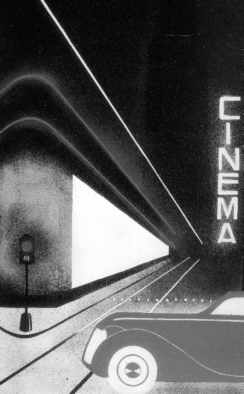 Organs, however, not only had popular appeal, but represented
large capital investment, and thus could not be economically
phased out at that stage. They also only required the employment
of an organist and a deputy, so the wages saved would only
represent a few pounds a week.
Organs, however, not only had popular appeal, but represented
large capital investment, and thus could not be economically
phased out at that stage. They also only required the employment
of an organist and a deputy, so the wages saved would only
represent a few pounds a week.
The arrival of sound films, boon as it was to the city cinemas, had the opposite effect on many smaller country theatres. These were in many cases unable to afford the installation of sound equipment at a time when audiences were decimated by unemployment of over 30 per cent, and they were unable to continue for long as silent houses, since the supply of new silent films soon dried up. The result was that they just closed, and between 1930 and 1935 the number of cinemas in operation throughout Australia fell from 1250 to 1090, despite the opening of several suburban "supers" during that time [Robertson, Patrick, The Guinness Book of Film Facts and Feats, Enfield, Middlesex, UK., 1980 p.205]. Even the Capitol Theatre, Sydney, went "dark" for several months in 1932-33; other cinemas, particularly in the cities, were converted to miniature golf courses, to cater for a new craze.